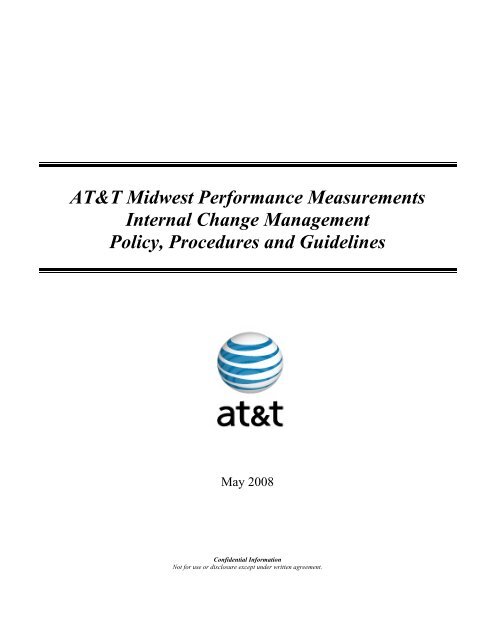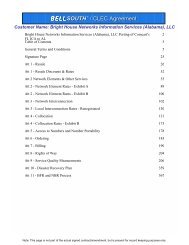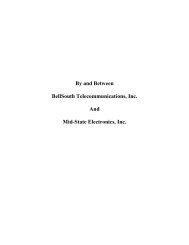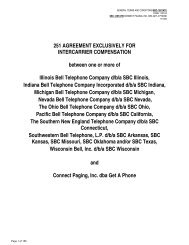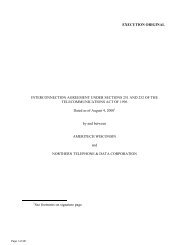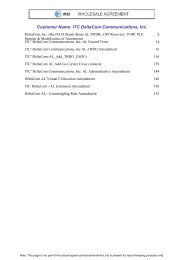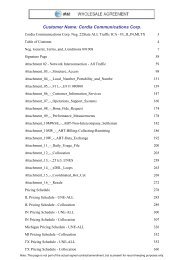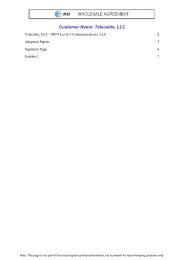Ameritech Performance Measures - AT&T Clec Online
Ameritech Performance Measures - AT&T Clec Online
Ameritech Performance Measures - AT&T Clec Online
Create successful ePaper yourself
Turn your PDF publications into a flip-book with our unique Google optimized e-Paper software.
AT&T Midwest <strong>Performance</strong> Measurements<br />
Internal Change Management<br />
Policy, Procedures and Guidelines<br />
May 2008<br />
Confidential Information<br />
Not for use or disclosure except under written agreement.
Table of Contents<br />
AT&T Midwest <strong>Performance</strong> Measurements<br />
Internal Change Management<br />
Policy, Procedures & Guidelines<br />
May 2008<br />
General Policy Statement Page 2<br />
Policy Objective Page 2<br />
Scope Page 2<br />
Definition of Terms Page 3<br />
Approvals Required Page 5<br />
General Responsibilities Page 6<br />
Process Overview Page 9<br />
0B1. Identify Need for Change<br />
2. 1BSubmit Change for Review by the PMCMT<br />
3. 2BConduct Weekly PMCMT Meeting<br />
4. 3BCommunicate Change to CLECs and Regulatory Agencies<br />
5. 4BChange Area Owner and Required Resource Assignment<br />
6. 5BDevelopment<br />
7. 6BTesting<br />
8. 7BImplementation<br />
9. 8BCommunicate Completion of Change Area X to Change Area X+1 Owner<br />
9B10. Change Closed<br />
10B11. Change Area Owner Updates Resource Assignments as Necessary<br />
11B12. Stop<br />
Standard Process Flow Page 13<br />
ADDENDUM<br />
12BA-1. Restatement Guidelines Page 14<br />
Confidential Information<br />
Not for use or disclosure except under written agreement.<br />
Page 1
General Policy Statement<br />
AT&T Midwest <strong>Performance</strong> Measurements<br />
Internal Change Management<br />
Policy, Procedures & Guidelines<br />
May 2008<br />
It is the policy of the AT&T Midwest <strong>Performance</strong> Measurement organization to adequately analyze, plan,<br />
and control the implementation of proposed changes to the systems, processes, and documentation<br />
supporting the creation and reporting of AT&T Midwest performance measurements. To this end, an<br />
internal change management process has been developed to address the workflow, communications and<br />
record keeping requirements of activities associated with the proposal, approval and implementation of<br />
changes to AT&T Midwest performance measurements. All proposed changes require the review and<br />
approval of the <strong>Performance</strong> Measurements Change Management Team (“PMCMT”). All AT&T personnel<br />
affiliated with the implementation of AT&T Midwest’s <strong>Performance</strong> Measurement are required to adhere<br />
to this policy and its provisions, as outlined herein.<br />
Policy Objective<br />
The ultimate objective of the change management process is to reduce the potential for adversely affecting<br />
the integrity of performance measurements reporting caused by the introduction of changes to AT&T<br />
Midwest's performance measurement systems and processes. In order to achieve these objectives, proposed<br />
changes, as defined in this policy, are required to be duly authorized, reviewed, and approved by the<br />
<strong>Performance</strong> Measurements Change Management Team prior to implementation.<br />
Scope<br />
This policy applies to:<br />
• The implementation of new performance measurements,<br />
• Changes to existing performance measurements and/or their implementation,<br />
• Updates to performance measurements documentation,<br />
• Changes to performance measurements systems,<br />
• Changes to performance measurements remedy plan programs,<br />
• Changes to processes for generating and reporting performance measurement results.<br />
Confidential Information<br />
Not for use or disclosure except under written agreement.<br />
Page 2
Definition of Terms<br />
AT&T Midwest <strong>Performance</strong> Measurements<br />
Internal Change Management<br />
Policy, Procedures & Guidelines<br />
May 2008<br />
Change Areas:<br />
Collection of systems, processes or documents impacted by a particular Enhancement Request.<br />
Change Area OwnerU:<br />
Individual responsible for addressing the resolution of a particular change area, ensuring the<br />
timely completion of the change, and communicating/updating the change area status to the<br />
PMCMT and/or CMPM.<br />
Change Management Database (CMDB):<br />
Tool and/or tools that facilitate documenting, tracking, and communicating the status of requested<br />
and approved changes to performance measurements to ensure their proper implementation.<br />
Change Management Project Manager (CMPM):<br />
Individual assigned the responsibility for the coordination of activities associated with the<br />
maintenance of changes to policy and procedure documentation, and for updating the Change<br />
Management Database to reflect the current state of the change management processes established<br />
for each change area and the administration of the CMDB.<br />
Documentation:<br />
• Data Flow Diagram (DFD): Data flows will reflect the location where measurement data<br />
is created as well as the entire system and/or manual path data flows from its root to<br />
measurement reporting.<br />
• Data Element Mapping (DEM): A spreadsheet with every data element used in the<br />
creation of performance measurements reports, providing the logic applied for any<br />
derived data elements and the path each element follows from its root to reporting.<br />
• Measurement Specific Business/Technical Requirements (BTR): Documentation<br />
compiled by measurement SMEs providing business and technical descriptions of how to<br />
calculate a performance measurement, including exclusions, inclusions, calculation logic<br />
and general procedures applied to produce measurement results.<br />
• System of Record (SOR): Identification of the system or systems responsible for data<br />
retention of a measurement’s root data.<br />
• System Retention Policy (SRP): Documentation identifying, for each System of Record,<br />
a system description, a data architecture overview, and details regarding performance<br />
measurement data retention.<br />
Enhancement Request (ER):<br />
Request for modification to a performance measurement implementation, system, process, or<br />
document.<br />
Enhancement Request Originator:<br />
Individual (any and all AT&T employees or agents of AT&T) that identifies and communicates<br />
need for a change to a performance measurement implementation, system, process, or document<br />
by submitting an ER to the PMCMT.<br />
Out-of-Process/Emergency Enhancement Requests:<br />
Requests for changes/enhancements/error corrections that are submitted to the CMPM in between<br />
scheduled PMCMT meetings requiring immediate action in order to accurately report performance<br />
measurement results. Requires director-level approval prior to submission for PMCMT approval.<br />
Confidential Information<br />
Not for use or disclosure except under written agreement.<br />
Page 3
AT&T Midwest <strong>Performance</strong> Measurements<br />
Internal Change Management<br />
Policy, Procedures & Guidelines<br />
May 2008<br />
<strong>Performance</strong> Measurement Business Process Owner:<br />
Individual/s representing the AT&T Business Unit responsible for the results/content reported for<br />
the performance measurement.<br />
<strong>Performance</strong> Measurements Change Management Team (PMCMT):<br />
Group of technical, process, and administrative experts with the assigned authority and<br />
responsibility to review and make implementation decisions on proposed changes to performance<br />
measurements.<br />
Production Environment Change Agent:<br />
Individual accountable for planning, coordinating, monitoring and communicating<br />
changes/enhancements within the IT source systems or their service delivery environments<br />
affecting the production/implementation of performance measurements and the reporting of their<br />
results.<br />
Restatement:<br />
Reprocessing and republishing of previously published performance measurement results. Posting<br />
of results to the web site is considered publishing of the results. The actual results published as a<br />
result of the restatement may or may not be different from the results previously published.<br />
(Addendum A-1, pages 14 through 16, details the AT&T Midwest <strong>Performance</strong> Measurement<br />
Restatement Guidelines).<br />
Confidential Information<br />
Not for use or disclosure except under written agreement.<br />
Page 4
Approvals Required<br />
AT&T Midwest <strong>Performance</strong> Measurements<br />
Internal Change Management<br />
Policy, Procedures & Guidelines<br />
May 2008<br />
Appropriate management review and authorization is required prior to implementation of a qualified<br />
change. To achieve this, all Enhancement Requests must receive the review of the performance<br />
measurement Business Owner and approval of the PMCMT. The PMCMT is vested with the authority to<br />
approve, reject with cause, or defer proposed changes. The decision of the PMCMT is to be communicated<br />
with explanation to the Enhancement Request Originator if the Originator and/or designate is not present<br />
during the PMCMT meeting where the request is discussed.<br />
Out-of-process/Emergency Enhancement Requests must receive Long Distance Compliance (LDC)<br />
<strong>Performance</strong> Measurements organization director-level approval with a notification to the PMCMT prior to<br />
implementation.<br />
Confidential Information<br />
Not for use or disclosure except under written agreement.<br />
Page 5
General Responsibilities<br />
AT&T Midwest <strong>Performance</strong> Measurements<br />
Internal Change Management<br />
Policy, Procedures & Guidelines<br />
May 2008<br />
U<strong>Performance</strong> Measurements Change Management Team:<br />
The <strong>Performance</strong> Measurements Change Management Team (PMCMT) has overall responsibility for the<br />
approval/disapproval of the implementation and prioritization of all enhancement requests. The<br />
responsibilities of PMCMT members include:<br />
• Attending regularly scheduled (i.e., weekly) PMCMT meetings;<br />
• Reviewing and evaluating qualified enhancement request documentation materials submitted by<br />
Enhancement Request Originators;<br />
• Evaluating/prioritizing all open Enhancement Requests (including identification of any additional<br />
operational, resource, or schedule considerations which should be weighed in the go/no-go decision);<br />
• Determining the completeness and quality of the analysis, planning and documentation required for the<br />
change and for determining the existence of operational or priority conflicts resulting from the<br />
proposed implementation date;<br />
• Ensuring that all affected change areas have been identified and assigning and confirming the<br />
assignment of Change Area Owners;<br />
• Recommending improvements to the Change Management Policy, its processes and procedures.<br />
Currently, the PMCMT is made up of representatives from the following responsibility/function areas:<br />
• Long Distance Compliance <strong>Performance</strong> Measurements Group;<br />
• Long Distance Compliance Mechanization <strong>Performance</strong> Measurements Group;<br />
• Long Distance Compliance <strong>Performance</strong> Measurements Analysis Group;<br />
• Long Distance Compliance <strong>Performance</strong> Measurements Production Group;<br />
• Long Distance Compliance Remedy Plan Program Group;<br />
• <strong>Performance</strong> Measurement Business Process Owners;<br />
• Other Process Groups.<br />
The PMCMT membership may be expanded as required to fulfill Change Management needs and business<br />
requirement implementation. The need to expand membership is determined by the CMPM with input<br />
from current members.<br />
The senior manager of the above responsibility/function areas determines the group’s representation.<br />
UEnhancement Request Originator:<br />
The Enhancement Request Originator is the initiator of the Enhancement Request. This individual, having<br />
identified the need for a performance measurement change, submits to the CMPM a Request for<br />
Enhancement for review by the PMCMT. A copy of the Request for Enhancement is forwarded to the<br />
Business Process Owner at the same time as to the CMPM.<br />
It is the Originator’s responsibility to ensure that the Request for Enhancement provides complete<br />
information and that the Business Process Owner is aware of the request.<br />
The Originator is also required to attend the PMCMT meeting during which the Originator reviews the<br />
request and responds to any raised questions. If the Originator is not able to attend the PMCMT meeting, it<br />
is the Originator’s responsibility to either ensure that the Business Process Owner is able to attend the<br />
meeting and is able to respond to raised questions or to assign a designate to attend the meeting and<br />
respond to raised questions.<br />
Confidential Information<br />
Not for use or disclosure except under written agreement.<br />
Page 6
AT&T Midwest <strong>Performance</strong> Measurements<br />
Internal Change Management<br />
Policy, Procedures & Guidelines<br />
May 2008<br />
AT&T personnel and/or duly authorized agents of AT&T must submit Requests for Enhancement Form<br />
whenever a change affects the way a performance measurement is implemented/reported. This includes,<br />
but is not exclusive of, changes made to<br />
• Documentation – such as: Data Flow Diagram (DFD), Data Element Mapping (DEM),<br />
Measurement Specific Business/Technical Requirements (BTR), System of Record (SOR),<br />
System Retention Policy (SRP) and/or other pertinent documents related to the implementation of<br />
a change;<br />
• Planned system changes/reporting system changes – such as: the introduction of new interfaces<br />
and/or the implementation of data sourcing systems;<br />
• Remedy plan program changes impacted by revised/new State Commission ordered plans,<br />
revised/new negotiated agreements, and changes in plan interpretation.<br />
U<strong>Performance</strong> Measurement Business Process Owner:<br />
The <strong>Performance</strong> Measurement Business Process Owner is the individual responsible for the ultimate<br />
implementation of changes to performance measurements within his/her area of responsibility.<br />
It is the Business Process Owner’s responsibility to:<br />
• Review received Requests for Enhancement;<br />
• Attend regularly scheduled PMCMT meetings (if unable to attend, send a representative);<br />
• Ensure that the implementation of the requested change/enhancement follows and is within the<br />
intent of the performance measurement business rule;<br />
• Communicate and obtain approval, as required, within their Business Unit, regarding the<br />
implementation of changes/enhancements;<br />
• Assist (as needed and requested) Change Area Owners so that the work required for change<br />
implementation occurs in a timely fashion;<br />
• Work with the Change Area Owners to ensure that all of the required documentation affecting the<br />
performance measurement change implementation has been updated;<br />
• Ensure that all affected downstream systems are involved in the change implementation and<br />
follow the required processes to effect the change;<br />
• Verify through available means, including review of the Verification web site results immediately<br />
prior to the first planned publishing of results with changes implemented, that the change has<br />
been implemented as defined by the Request for Enhancement;<br />
• Provide positive notification to the CMPM that performance results generated with the revised<br />
implementation are ready for publication after reviewing the accuracy and completeness of the<br />
changes on the Verification web site;<br />
• Review the actual published data and results to verify the production posting reflects the correct<br />
implementation; and<br />
• Inform the CMPM the enhancement request is complete and can be closed.<br />
UChange Management Project Manager (CMPM):<br />
The CMPM is responsible for operational issues relating to the change management process and the<br />
administration of the CMDB, as well as having overall responsibility for coordinating and tracking progress<br />
in all affected change areas. The responsibilities of the CMPM include the following activities:<br />
• Maintaining the Change Management Policy and distributing the document revisions to authorized<br />
recipients;<br />
• Performing required CMDB administrative duties, updating ER status where appropriate, updating ER<br />
priority, creating status reports for the PMCMT meeting;<br />
Confidential Information<br />
Not for use or disclosure except under written agreement.<br />
Page 7
AT&T Midwest <strong>Performance</strong> Measurements<br />
Internal Change Management<br />
Policy, Procedures & Guidelines<br />
May 2008<br />
• If the Enhancement Request Originator is not present at the PMCMT meeting, as soon as possible<br />
following the PMCMT meeting during which the request is presented to the PMCMT, the Originator<br />
of the ER is notified by the CMPM of the PMCMT decision. Should a Request for Enhancement be<br />
accompanied by supplemental documentation, this documentation is forwarded to the Business Process<br />
Owner of the addressed/affected performance measurement;<br />
• Coordinating and tracking progress status in affected change areas;<br />
• Preventing changes from being implemented in production unless proper approvals have been<br />
obtained; and<br />
• Providing education and training in the Change Management Policy as required.<br />
UChange Area Owner:<br />
The Change Area Owner is the primary driver of the changes and is responsible for addressing the<br />
resolution (and/or working with resources to address the resolution) of a particular change area, for<br />
ensuring the timely completion of the change, and for communicating/updating the change area status to<br />
the Business Process Owner, PMCMT and the CMPM. The responsibilities of the Change Area Owner<br />
include the following activities:<br />
• Resolving and/or working with resources to resolve the change area;<br />
• Determining and assigning timelines for the different required steps to complete the change;<br />
• Assuming responsibility for the coordination of all implementation activities within their change area<br />
and coordinating activities with other change areas as appropriate;<br />
• Updating the status and progress of the change to the Business Process Owner, PMCMT and the<br />
CMPM.<br />
UProduction Environment Change Agent:<br />
The Production Environment Change Agent is accountable for ensuring that all necessary plans and quality<br />
assurance steps have been taken (as defined by internal, system-specific processes) assuring a timely,<br />
accurate and successful change implementation. The Change Agent is responsible for:<br />
• Initiating a Request for Enhancement whenever a change is necessitated to reporting<br />
systems/applications/processes (including all affiliated documentation);<br />
• Communicating the need for a system change to the performance measurement Business Process<br />
Owner;<br />
• Ensuring that the identified change/enhancement is scheduled and implemented at a time and in a<br />
manner least likely to affect production availability;<br />
• Attending (or sending a representative) to the PMCMT meeting and keeping the PMCMT,<br />
Business Process Owner, Change Area Owner informed of the status of the system<br />
change/enhancement;<br />
• Assisting in the resolution of unanticipated concerns;<br />
• Ensuring the full, complete and accurate documentation of the change/enhancement.<br />
Confidential Information<br />
Not for use or disclosure except under written agreement.<br />
Page 8
Process Overview<br />
1. Identify Need for Change<br />
AT&T Midwest <strong>Performance</strong> Measurements<br />
Internal Change Management<br />
Policy, Procedures & Guidelines<br />
May 2008<br />
Problems and/or required/desired enhancements within the current performance measurements<br />
environment are identified by any of a number of AT&T personnel.<br />
2. Submit Change for Review by the PMCMT<br />
A request to address the required/desired enhancement is submitted by the Enhancement Request<br />
Originator to the CMPM with a copy to the <strong>Performance</strong> Measurement Business Process Owner. The<br />
information provided is entered onto the Potential ERs matrix by the CMPM, and is subject to review<br />
by the PMCMT.<br />
Requests for Enhancement must be completed and submitted for all changes pertaining to the<br />
implementation and publication of performance measurement results. The types of changes that would<br />
require a submission of a Request for Enhancement include, but are not exclusive of, the following:<br />
• Adding of a New Measurement – as approved/required/mandated by the CLEC<br />
Collaborative and State Commissions and the FCC;<br />
• Documentation changes (Data Flow Diagrams, Data Element Maps, Measurement<br />
Specific Business/Technical Requirements, System of Record, System Retention Policy);<br />
• Planned System Changes/Production Environment Changes (changes to interfaces and/or<br />
computer/reporting systems supporting the generation of performance measurement<br />
data—based on the <strong>Performance</strong> Measurement Business Process Owner’s assessment of<br />
the change impact on the reporting of performance measurement results);<br />
• Improvements required by business rule interpretation, system/processing changes,<br />
program code modifications, change in calculation, criteria logic changes, etc.;<br />
• Error correction required for erroneously provided data, data input errors,<br />
system/processing problems, incomplete data, erroneous criteria/logic<br />
application/interpretation;<br />
• Information gathering/analysis/internal audit;<br />
• Web display modification;<br />
• Remedy plans program changes.<br />
3. Conduct Weekly PMCMT Meeting<br />
A. Evaluate Status of Open and New Enhancement Requests<br />
Each Change Area Owner and/or Business Process Owner provides an update on the progress of<br />
implementation/change activities against established timelines. When necessary, updates to the<br />
priority assignment may be made, and should be updated in the CMDB.<br />
B. Prioritize all Open and New Enhancement Requests (Assign Timelines)<br />
For all new ERs, a priority must be assigned based upon agreement from the PMCMT. Generally,<br />
the following criteria are used to establish a priority:<br />
• Critical Priority – ERs relating to Commission-ordered changes with mandated<br />
implementation dates, changes required due to OSS changes with specific implementation<br />
dates that must be implemented to continue reporting accurate PM results in compliance with<br />
Confidential Information<br />
Not for use or disclosure except under written agreement.<br />
Page 9
AT&T Midwest <strong>Performance</strong> Measurements<br />
Internal Change Management<br />
Policy, Procedures & Guidelines<br />
May 2008<br />
regulatory or contractual obligations, and resolution of implementation defects that materially<br />
affect performance results.<br />
• High Priority – ERs concerned with implementing Commission-ordered changes without<br />
mandated implementation dates, changes required due to OSS changes that must be<br />
implemented to continue reporting accurate PM results in compliance with regulatory or<br />
contractual obligations, and resolution of known defects that result in inaccurate reporting of<br />
results (but not materially inaccurate).<br />
• Medium Priority – ERs concerned with implementing Commission discussed and internal<br />
data collection and reporting changes required to more accurately report the agreed-upon<br />
business rules, and ad-hoc data and or processing requests required to perform restatement or<br />
assess materiality of an issue.<br />
• Low Priority – ERs concerned with implementing internal data collection and reporting<br />
process improvements or to address ad-hoc data or processing requests that have no impact on<br />
reporting accuracy or compliance with regulatory or contractual obligations.<br />
All existing ERs should be reviewed to ensure that the assigned priority is still applicable based<br />
upon activities during the prior week.<br />
The CMPM is responsible for updating the CMDB with the appropriate priority for all ERs.<br />
4. Communicate Change to CLECs and Regulatory Agencies<br />
AT&T Midwest’s performance measurement Change Management Process requires that AT&T<br />
Midwest notify the industry in advance of planned modifications to performance measurements as<br />
charted below.<br />
NOTE: AT&T Midwest is not under obligation to notify CLECs and/or Commissions of changes to an internal<br />
system or process when such is required in order for AT&T Midwest to continue properly reporting performance<br />
measurement results.<br />
Additionally, modifications to the web site itself will be communicated via an Accessible Letter, which<br />
is the standard communication vehicle used in AT&T for communication to CLECs and regulatory<br />
agencies. Commission staff representatives and CLEC contact personnel receive the Accessible<br />
Letters via e-mail and the Accessible Letters are posted to the AT&T web site. These vehicles will<br />
ensure that CLECs receive the appropriate information and notices, as well as AT&T’s account<br />
managers, who are then better able to support the necessary information exchanges.<br />
Suggested notification intervals for changes to performance measurements are:<br />
Type of Change Minimum Notice Interval<br />
1. New Measurement 30 days prior to implementation via<br />
implementation schedule<br />
2. Changed Business Rules 30 days prior to implementation via<br />
implementation schedule<br />
3. Changed Report Format (Electronic) 30 days prior to implementation via<br />
Accessible Letter<br />
4. Change Requiring Restatement of<br />
Previously Reported Results<br />
Confidential Information<br />
Not for use or disclosure except under written agreement.<br />
At the next posting or re-posting date via<br />
Web Page Notification<br />
Page 10
AT&T Midwest <strong>Performance</strong> Measurements<br />
Internal Change Management<br />
Policy, Procedures & Guidelines<br />
May 2008<br />
5. Change Area Owner and Required Resource Assignment:<br />
The Change Area Owner is responsible for addressing (and/or working with resources to address) the<br />
resolution of a particular change area. The different types of changes may require the utilization of<br />
different resources. It is the Change Area Owner’s (together with the <strong>Performance</strong> Measurement<br />
Business Process Owner’s) responsibility to obtain and work with the required resources.<br />
The Change Area Owner should also ensure the timely completion of the change and should<br />
communicate/update the Change Area status to the <strong>Performance</strong> Measurement Business Process<br />
Owner, the PMCMT and in the CMPM.<br />
6. Development<br />
For changes to performance measurements, systemic or manual processes will need to be developed to<br />
address the change (e.g., for new measurements, processes will need to be created for collecting data<br />
from the appropriate source system(s), calculating the measurement in the measurement reporting<br />
systems, and reporting the measurement results on the web site.<br />
The Change Area Owner is responsible for updating the <strong>Performance</strong> Measurement Business Process<br />
Owner, the CMPM and the PMCMT. Such updates usually occur as part of the weekly PMCMT<br />
meeting. The CMPM is responsible for updating the status of the ER in the CMDB as part of the<br />
normal updating process.<br />
7. Testing<br />
Thorough testing of processes that have been changed/created during the Development phase needs to<br />
occur to ensure that the systems/processes are functioning properly before and after implementation.<br />
This testing includes review of results on the Verification web site by the Business Owner to ensure<br />
accuracy prior to publication.<br />
The Change Area Owner is responsible for ensuring that the data provided for implementation is<br />
accurate and informing the <strong>Performance</strong> Measurement Business Process Owner, the PMCMT and the<br />
CMPM during the weekly update meetings that the change is ready to be implemented. The CMPM<br />
then updates the CMDB as part of the usual CMDB update process.<br />
8. Implementation<br />
Changes are deemed ready for implementation when the Change Area Owner informs the <strong>Performance</strong><br />
Measurement Business Process Owner, the PMCMT, and the CMPM that the change is ready to be<br />
reported.<br />
The CMPM is responsible for updating the status of the ER in the CMDB when the change is ready to<br />
be implemented as part of the usual CMDB update process.<br />
9. Communicate Completion of Change Area X to Change Area X+1 Owner<br />
A particular ER may impact several Change Areas (e.g., a new measurement will require changes to<br />
(1) the measurement reporting systems, (2) documentation, and (3) the web site). It may not be<br />
possible to address all of these Change Areas concurrently. When a change has been completed in one<br />
Change Area, and other Change Areas that are impacted by the ER have not yet been addressed, the<br />
Change Area Owner must appropriately communicate completion to the owner of other impacted<br />
Change Areas. The PMCMT and the CMPM needs to be updated of such communication during the<br />
weekly PMCMT meeting.<br />
Confidential Information<br />
Not for use or disclosure except under written agreement.<br />
Page 11
AT&T Midwest <strong>Performance</strong> Measurements<br />
Internal Change Management<br />
Policy, Procedures & Guidelines<br />
May 2008<br />
Should the Change Area Owner and/or the CMPM deem it necessary, a new Request for Enhancement<br />
may be created to track additional changes.<br />
10. Change Closed<br />
An ER is deemed ready for closure when the following actions have occurred:<br />
• Implementation of a particular change area (once the change has been effected on the web and<br />
the Change Area Owner and/or Business Owner has communicated that the change is<br />
completed),<br />
• No other areas are affected by the ER<br />
• The CMPM designates the ER as “complete” in the CMDB and issues a “Request for Signoff”<br />
to the Business Process Owners and/or Change Area Owners.<br />
The Business Process Owners and/or Change Area owners indicate in writing that the specific ER can<br />
be closed as complete. The CMPM updates the status of the ER in the CMDB to be “Closed”,<br />
indicates the date that the sign-off was received and, as the final update, enters the date and from<br />
whom the sign-off was received in the Update field.<br />
11. Change Area Owner Updates Resource Assignments as Necessary<br />
If during the weekly meetings of the PMCMT, the priority of a particular ER is changed (and the<br />
implementation timelines thus change), the Change Area Owner may need to reprioritize resource<br />
assignments for addressing the ER.<br />
See Step 5: Change Area Owner and Required Resource Assignment for details on the process.<br />
The CMPM is responsible for updating the priority of the ER in the CMDB.<br />
12. Stop<br />
If an outstanding ER is being reviewed in the weekly PMCMT meeting and does not have a change in<br />
priority, no additional action is necessary at that time.<br />
Confidential Information<br />
Not for use or disclosure except under written agreement.<br />
Page 12
Standard Process Flow<br />
AT&T Midwest <strong>Performance</strong> Measurements<br />
Internal Change Management<br />
Policy, Procedures & Guidelines<br />
May 2008<br />
AT&T Midwest's performance measurement Change Management Process flow is defined as follows:<br />
Identify<br />
Need for Change<br />
Change<br />
Closed<br />
No<br />
1 2<br />
Submit Change<br />
for Review<br />
by PMCMT<br />
10 4<br />
Other Areas<br />
Affected<br />
8<br />
Yes<br />
Communicate<br />
Change to CLECs<br />
and Regulatory<br />
Agencies<br />
Implementation Testing<br />
9<br />
Communicate<br />
Completion of<br />
Change Area X to<br />
Change Area X+1<br />
Owner<br />
7<br />
Evaluate Status<br />
of all Open and<br />
New ERs<br />
Determine Areas<br />
Affected by<br />
Change and<br />
Assign Owners<br />
Change Area<br />
Owner Assigns<br />
Resources<br />
Development<br />
Yes<br />
Confidential Information<br />
Not for use or disclosure except under written agreement.<br />
5<br />
6<br />
3A 3B<br />
3C<br />
Prioritize all Open<br />
and New ERs<br />
(Assign Timelines)<br />
11<br />
New<br />
Request<br />
No<br />
Change in<br />
Priority?<br />
Yes<br />
Change Area<br />
Owner Updates<br />
Resource<br />
Assignments as<br />
Necessary<br />
No<br />
Page 13<br />
Process Occurs<br />
in PMCMT<br />
Weekly Meeting<br />
Process Requires<br />
Update to the<br />
CMDB<br />
12<br />
Stop
AT&T Midwest <strong>Performance</strong> Measurements<br />
Internal Change Management<br />
Policy, Procedures & Guidelines<br />
May 2008<br />
ADDENDUM<br />
AT&T Midwest <strong>Performance</strong> Measurement<br />
Restatement Guidelines<br />
(Eff. December 7, 2001)<br />
Revised March, 2006<br />
Restatement requests follow the process set forth in the AT&T Midwest <strong>Performance</strong> Measurements<br />
Internal Change Management Policy, Procedures & Guidelines. There are occasions when it is recognized<br />
after publication that the performance measures data that has been published is incomplete or incorrect.<br />
Dealing with these occasions is the subject of this addendum.<br />
Restatement Defined<br />
Any time previously published performance measurement results are recalculated and republished, a<br />
restatement of the results previously published has occurred. Posting of results to the web site is<br />
considered publishing of the results. The actual results published as a result of the restatement may or may<br />
not be different from the results previously published.<br />
The determination of whether or not to restate results depends upon the materiality of any changes to<br />
previously reported results. AT&T Midwest defaults to restating the published results unless it can be<br />
determined, through reasonable analysis that can be completed in a timely fashion, that the restated results<br />
would not be materially different from the results originally published. AT&T Midwest does not conduct<br />
this analysis on every restatement, and in those cases instead chooses to restate regardless of materiality.<br />
The process to determine the materiality of any changes is discussed below under the section header<br />
"Materiality Determination".<br />
Materiality Determination<br />
Materiality is determined based upon two factors:<br />
1. <strong>Performance</strong> calculations that result in a shift in the performance in the aggregate from a “make”<br />
condition to a “miss” condition.<br />
2. <strong>Performance</strong> calculations that result in a further degradation of reported performance of more than<br />
5% for measures that are in a “miss” condition, provided there are at least 100 CLEC transactions<br />
in the sub-metric.<br />
Analysis of incomplete or incorrect performance measure results will be conducted to determine if either of<br />
the two conditions above is met, or restatement will be undertaken. This analysis normally will include, at<br />
minimum, the three months of results reported immediately prior to the implementation of corrective<br />
actions. However, if the start date of the issue can be clearly identified, analysis of reported results need<br />
not include months prior to such date. All months analyzed that meet the above criteria must be restated.<br />
An analysis of each month in question may not be required if one of the following two conditions is met:<br />
• A review of a portion of the months requiring analysis indicates performance measure data is<br />
significantly incomplete or incorrect and the Business Owner deems it prudent to restate all<br />
months in question.<br />
• It can be determined by an abbreviated analysis or logic that correcting the situation in question<br />
will only improve results.<br />
Confidential Information<br />
Not for use or disclosure except under written agreement.<br />
Page 14
AT&T Midwest <strong>Performance</strong> Measurements<br />
Internal Change Management<br />
Policy, Procedures & Guidelines<br />
May 2008<br />
For measurements that are purely diagnostic (i.e. are not subject to remedies and have no established<br />
benchmark or comparison), generally restatements will not be made. AT&T reserves the right to restate<br />
results in certain situations regardless of materiality. These restatements will be made only with the<br />
approval of the General Manager, <strong>Performance</strong> <strong>Measures</strong>.<br />
Results of the materiality analyses must be documented in the CMDB. Analysis of materiality must<br />
include an assessment of the impact of a change on any related measures (e.g. measures which should have<br />
the same denominator value, though numerator values may differ), and explicit documentation of what<br />
changes are being assessed when the impact of more than one change is included in the materiality<br />
analysis, so that understanding of the full impact of the corrective action or actions can be identified. In<br />
addition, the performance measure Business Owner must identify the solution implemented to correct the<br />
problem and what steps (if applicable) have been taken to minimize the chances of the same or similar<br />
problems occurring in the future.<br />
Implementation of Restatements<br />
Determining when to implement restatements is dependent upon (a) the complexity of implementing the<br />
improvements/corrections, and/or (b) the availability of performance measurement reporting resources<br />
required to both re-process the data and results for the measurement being restated and also meet the<br />
monthly production reporting obligations.<br />
In the event a restatement is to be made on the 20 th of a month to avoid paying remedies on that day, data<br />
must be processed in accordance with the timeline below. The key date in this timeline in order to avoid<br />
making remedy payments is the 14 th of the month. This is the final day a completed remedy file is provided<br />
to billing (Finance) for processing.<br />
1. The final CLEC data file (including restatements) must be to Bob Costello by the 5 th of each<br />
month.<br />
2. Up to two days are required by Bob to run the remedy program that produces the remedy file used<br />
by Rick Frevert.<br />
3. Rick prepares numerous preliminary reports that are issued for review.<br />
4. Individuals reviewing preliminary reports have two days to review remedy data and notify Jim<br />
Ehr, Bob Costello, and Rick Frevert of changes once notification is received that data is available<br />
for inspection. If no “red flag” is raised after two days, the payment file is sent to billing<br />
(generally around the 9 th or 10 th of the month) and is final.<br />
5. If a data restatement is required or a remedy record withheld, the remedies group must be notified<br />
within 24 hours.<br />
6. A final remedy file with changes if required is made available no later than the 14 th of the month.<br />
Preliminary reports are then updated and the payment file is created and sent to billing (Finance)<br />
for processing.<br />
7. Once the payment file has been sent to billing, there Umight Ube a 24 hour window in which<br />
adjustments can be made. This should be considered the exception rather than the rule.<br />
8. Once the payment file is created, it is final.<br />
The 14 th of the month should be considered the worst case scenario. The remedy file can be sent to billing<br />
as early as the 9 th or 10 th if Bob Costello is able to run his remedy program in less than a day. It is<br />
imperative that individuals reviewing preliminary reports scrub their data during their two day review<br />
period and raise any issues at this time. If no comments or concerns are expressed during this time, it is<br />
understood that the files are acceptable as provided.<br />
Notification of Material Restatements<br />
Confidential Information<br />
Not for use or disclosure except under written agreement.<br />
Page 15
AT&T Midwest <strong>Performance</strong> Measurements<br />
Internal Change Management<br />
Policy, Procedures & Guidelines<br />
May 2008<br />
Notification of material restatement is made to CLECs and State Commissions via the News Page on the<br />
CLEC <strong>Online</strong> website (Hhttps://clec.sbc.com/clecH). This notification provides a listing of the specific results<br />
being recalculated and reposted (PMs and months) and an explanation of why the restatement is required.<br />
Text defining the performance measures and months of result being recalculated and reposted, along with<br />
an explanation of the issue that drives the need for recalculation and reposting of results is compiled into a<br />
draft News Page by the CMPM. This draft notice is based upon the information documented in the Change<br />
Management Database through the Change Management Process. The Director-Change Management<br />
reviews the draft News Page for completeness, accuracy and readability. The Director-<strong>Performance</strong><br />
Measurement also reviews the draft News Page for completeness, accuracy and readability. The monthly<br />
Additions and Modifications matrix is utilized as the primary source for reviewing accuracy. Any<br />
modifications are jointly agreed upon and approval of both Directors is obtained. The approved version of<br />
the News Page is posted on the web site upon completion of results loading.<br />
Posting of restatements generally occurs on either the normal scheduled reporting date (the 20 th of the<br />
month or the first business day thereafter should the 20 th fall on a holiday or weekend) or the 5 th calendar<br />
day of the following month (or the next business day should the 5 th fall on a weekend or holiday). Any outof-cycle<br />
restatements will be made only with the approval of the General Manager, <strong>Performance</strong> <strong>Measures</strong>.<br />
In no case should AT&T’s notification of recalculation and reposting of results be considered a guarantee<br />
of differences in newly published results from previously published results. Notices of material<br />
restatements indicate only which performance measurement results have been/will be restated (as defined<br />
under “Restatement Defined” above). Previously posted results will not necessarily change in every<br />
situation. The CLEC specific report will list the actual performance measurement changes that affected<br />
that CLEC. An aggregate report will reflect the changes that impact State results.<br />
Confidential Information<br />
Not for use or disclosure except under written agreement.<br />
Page 16


